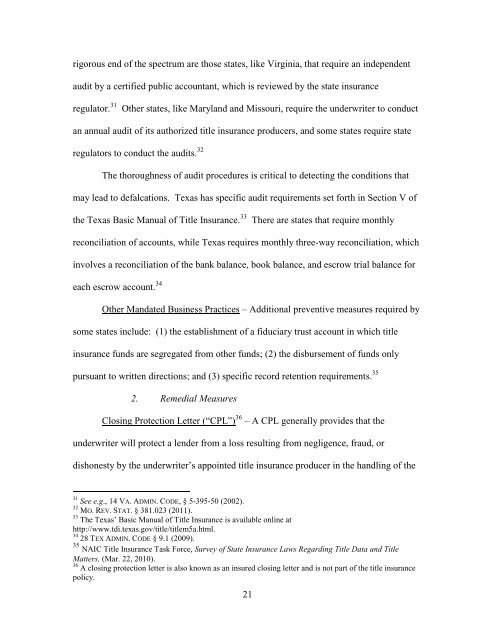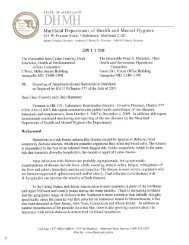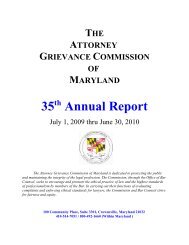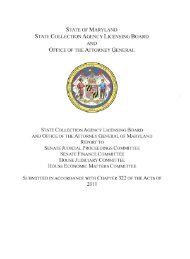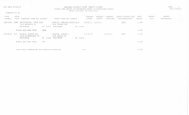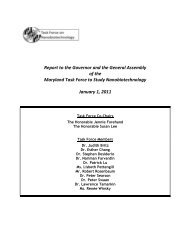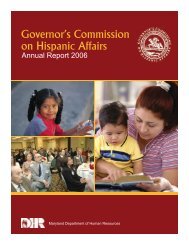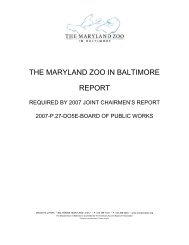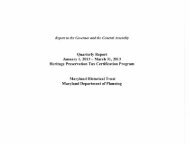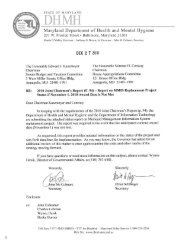report of the commissioner to study - Maryland Insurance ...
report of the commissioner to study - Maryland Insurance ...
report of the commissioner to study - Maryland Insurance ...
Create successful ePaper yourself
Turn your PDF publications into a flip-book with our unique Google optimized e-Paper software.
igorous end <strong>of</strong> <strong>the</strong> spectrum are those states, like Virginia, that require an independentaudit by a certified public accountant, which is reviewed by <strong>the</strong> state insuranceregula<strong>to</strong>r. 31O<strong>the</strong>r states, like <strong>Maryland</strong> and Missouri, require <strong>the</strong> underwriter <strong>to</strong> conductan annual audit <strong>of</strong> its authorized title insurance producers, and some states require stateregula<strong>to</strong>rs <strong>to</strong> conduct <strong>the</strong> audits. 32The thoroughness <strong>of</strong> audit procedures is critical <strong>to</strong> detecting <strong>the</strong> conditions thatmay lead <strong>to</strong> defalcations. Texas has specific audit requirements set forth in Section V <strong>of</strong><strong>the</strong> Texas Basic Manual <strong>of</strong> Title <strong>Insurance</strong>. 33There are states that require monthlyreconciliation <strong>of</strong> accounts, while Texas requires monthly three-way reconciliation, whichinvolves a reconciliation <strong>of</strong> <strong>the</strong> bank balance, book balance, and escrow trial balance foreach escrow account. 34O<strong>the</strong>r Mandated Business Practices – Additional preventive measures required bysome states include: (1) <strong>the</strong> establishment <strong>of</strong> a fiduciary trust account in which titleinsurance funds are segregated from o<strong>the</strong>r funds; (2) <strong>the</strong> disbursement <strong>of</strong> funds onlypursuant <strong>to</strong> written directions; and (3) specific record retention requirements. 352. Remedial MeasuresClosing Protection Letter (“CPL”) 36 – A CPL generally provides that <strong>the</strong>underwriter will protect a lender from a loss resulting from negligence, fraud, ordishonesty by <strong>the</strong> underwriter’s appointed title insurance producer in <strong>the</strong> handling <strong>of</strong> <strong>the</strong>31 See e.g., 14 VA. ADMIN. CODE, § 5-395-50 (2002).32 MO. REV. STAT. § 381.023 (2011).33 The Texas’ Basic Manual <strong>of</strong> Title <strong>Insurance</strong> is available online athttp://www.tdi.texas.gov/title/titlem5a.html.34 28 TEX ADMIN. CODE § 9.1 (2009).35 NAIC Title <strong>Insurance</strong> Task Force, Survey <strong>of</strong> State <strong>Insurance</strong> Laws Regarding Title Data and TitleMatters, (Mar. 22, 2010).36 A closing protection letter is also known as an insured closing letter and is not part <strong>of</strong> <strong>the</strong> title insurancepolicy.21


